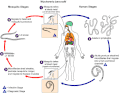Fil:Wuchereria bancrofti LifeCycle.gif
Wuchereria_bancrofti_LifeCycle.gif (513 × 435 pikslar, filstorleik: 33 KB, MIME-type: image/gif)

Følgjande er henta frå filomtalen åt denne fila på Wikimedia Commons:
Filhistorikk
Klikk på dato/klokkeslett for å sjå fila slik ho var på det tidspunktet.
| Dato/klokkeslett | Miniatyrbilete | Oppløysing | Brukar | Kommentar | |
|---|---|---|---|---|---|
| gjeldande | 5. november 2008 kl. 16:15 |  | 513 × 435 (33 KB) | Lycaon | Watermark removed |
| 14. mai 2006 kl. 23:02 |  | 513 × 435 (36 KB) | Patho | {{Information| |Description=Filariasis [Brugia malayi] [Brugia timori] [Loa loa] [Mansonella ozzardi] [Mansonella perstans] [Mansonella streptocerca] [Onchocerca volvulus] [Wuchereria bancrofti] Life cycle of Wuchereria bancrofti Different species |
Filbruk
Den følgjande sida bruker denne fila:
Global filbruk
Desse andre wikiane nyttar fila:
- Bruk på ceb.wikipedia.org
- Bruk på de.wikipedia.org
- Bruk på de.wikibooks.org
- Bruk på en.wikipedia.org
- Bruk på fr.wikipedia.org
- Bruk på hu.wikibooks.org
- Bruk på pl.wikipedia.org
- Bruk på sv.wikipedia.org

